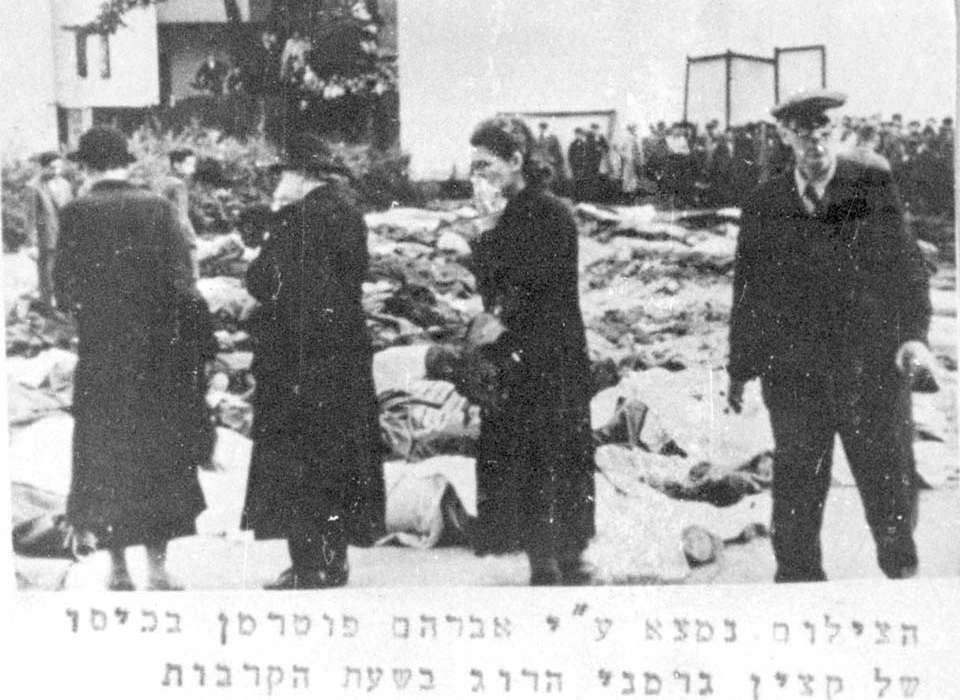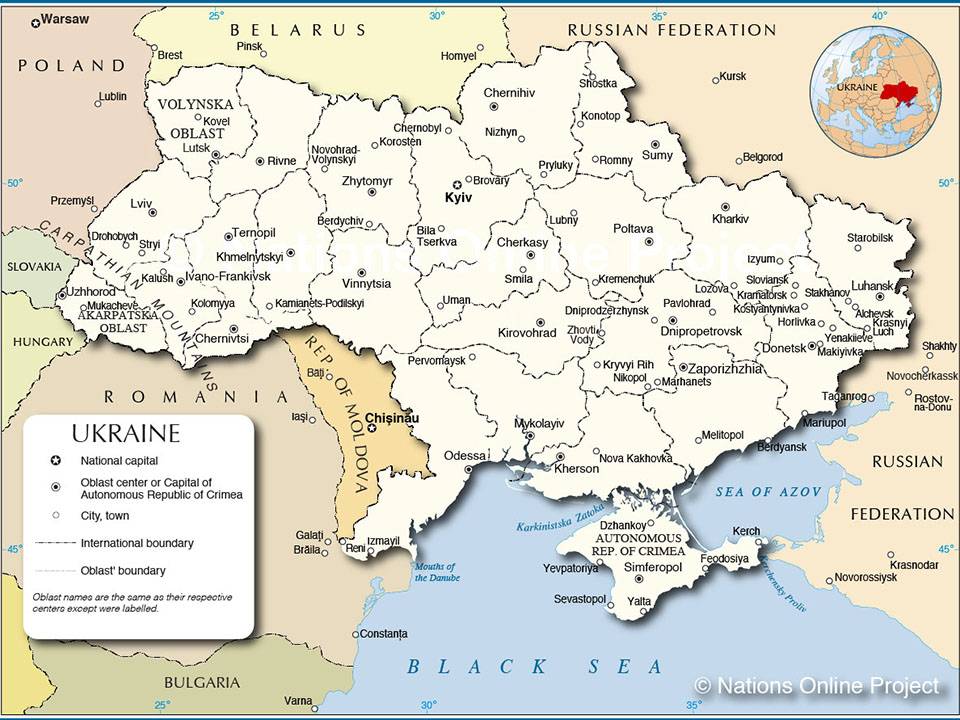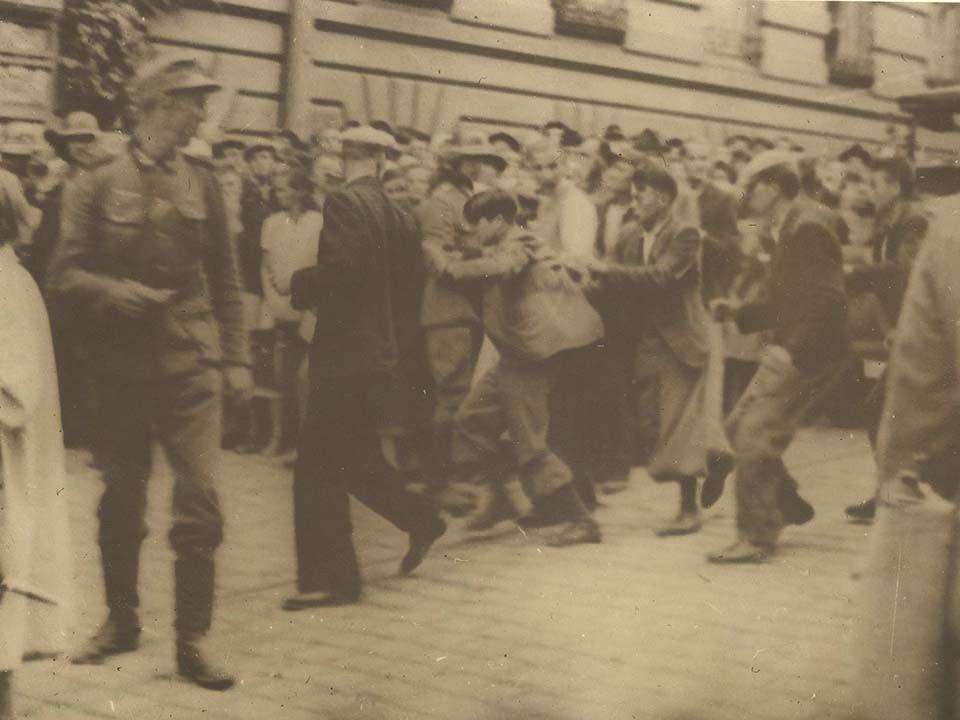Top Image: Locals identifying prisoners who were murdered by the NKVD before the Soviet withdrawal in L’viv, July 1941. Courtesy of Yad Vashem Photo Archive.
As the German army began its invasion of the Soviet Union on June 22, 1941, Stalin ordered the Soviet Secret Service (NKVD) to “remove” the prison population in the USSR’s occupied territories rather than allow them to fall into German hands. This was largely accomplished through the mass murder of prisoners at various locations in Western Ukraine, Belarus, Estonia, and Lithuania. The majority of the mass executions, later termed “the 1941 NKVD Prison Massacres” by local residents, occurred in Western Ukraine. Due to a lack of reliable sources, exact numbers are impossible to determine; however, historians estimate that the NKVD killed somewhere between 10,000 and 40,000 people in dozens of prisons over the course of eight days. The ethnic breakdown of casualties in Western Ukraine roughly corresponded to population demographics: 70 percent of the victims were Ukrainian, 20 percent Polish, and the remainder consisted of Jews and other nationalities.
Western Ukraine, which encompasses the historical regions of Transcarpathia, Eastern Galicia, Volhynia, northern Bukovina, and the western parts of Podolia, had been a part of Poland prior to the outbreak of World War II. Following the joint invasion of Poland by Germany and the Soviet Union in September 1939, Western Ukraine came under Soviet rule and was incorporated into the Ukrainian Soviet Socialist Republic until the Nazis invaded the USSR, at which point the region remained under Nazi control until the Red Army began retaking Ukrainian territory in 1944.
Map of present-day Ukrainian oblasts, or administrative districts. The region of Western Ukraine generally includes the following present-day oblasts: Ivano-Frankivsk, Khmelnitsky, L’viv, Rivne, Ternopil, Volyn, and Zakarpattia.
The Soviet occupation of Western Ukraine was characterized by terror and repression as Stalin immediately embarked on a Sovietization drive that not only included the distribution and display of Soviet insignia and propaganda, but also involved a massive campaign against perceived “enemies of the state.” Due to Stalin’s fear of any national or anti-Soviet elements, hundreds of thousands of suspected political adversaries were arrested, imprisoned, deported to Siberia or Kazakhstan, or executed en masse between February and June 1940. Initial arrests and deportations focused on anti-communists, prewar Polish elites, civil servants, governmental officials, military officers, and Ukrainian nationalists. By April 1940, however, the NKVD began arresting a wide variety of people including family members of those previously convicted, as well as prominent doctors, engineers, lawyers, journalists, artists, university professors, teachers, merchants, and well-to-do farmers. Those that avoided immediate deportation or death sentences remained locked in NKVD prisons when the Germans launched their assault on the Soviet Union.
It is estimated that close to 140,000 political prisoners were being held in prisons throughout Soviet-occupied territories on the eve of Operation Barbarossa. Upon hearing news of the German invasion, the NKVD was ordered to evacuate and liquidate all political prisoners under evacuation order No. 00803.
In Western Ukraine the NKVD started to execute prisoners on the morning of June 23, regardless of whether they had been incarcerated for major offenses or were merely waiting to be questioned. In the central prison in the city of Lutsk, located in the northwestern oblast of Volyn, inmates were crowded and locked into small cells under the pretense of a large-scale evacuation. Shortly thereafter, NKVD officers called inmates by name into the courtyard, lined them up, and began throwing grenades at the group while Soviet tanks fired machine guns. A handful of survivors were then forced to spend the rest of the day digging graves and burying corpses until their overseers fled an advancing German unit. Casualty estimates from the Lutsk prison massacre vary based on sources, ranging from 1,500 to 4,000.
“It was as if the herald of death had appeared in our cell, and we had heard his message.”
Bodhan Kazanivs’kyi, survivor of 1941 prison massacres
NKVD extermination procedures varied from prison to prison, depending on the number of prisoners to be executed, with some prisoners systematically shot in the back of the neck or burned alive in locked cells. Inmates incarcerated in the three-story prison of Dubno, located in the Rivne oblast, were shot and stabbed with bayonets while they slept.
On June 26, 1941, the NKVD blew up two large cells filled with approximately 1,200 female prisoners in Sambir, a city located about 80 kilometers southwest of L’viv. In the city of Ivano-Frankivsk, formerly known as Stanyslaviv, three large basement cells had been stacked to the ceiling with close to 2,500 dead bodies. In the NKVD investigative prison in L’viv, Soviet authorities threw the victims, dead or alive, into basement cells, locked the doors, and set fire to the building in an attempt to hide their crimes. Other major sites of massacres include Zolochiv and Dobromyl in the L’viv oblast, Chortkiv in the Ternopil oblast, and the city of Rivne in the Rivne oblast. It is estimated that between 800 and 1,500 prisoners died in each of these locations.
It was not only the number of those killed that shocked the populace, but also the manner in which they died. Many of the prisoners killed at the hands of the NKVD in Western Ukraine endured brutal torture before being killed. The first known reports of the NKVD prison massacres appeared in German newspapers in the first week of July 1940 and described scenes of family members searching through thousands of tortured corpses. An unattributed report from Berlin reported that victims in L’viv were crowded into cells where they were either shot or had their stomachs cut open. Similarly horrific reports recount crucified priests with crosses carved into their chests, makeshift torture chambers with blood-soaked walls, and mass graves full of bodies displaying marks of torture and missing limbs.
Eyewitness accounts confirm the brutal manner in which some prisoners were tortured and then murdered. Bohdan Kazanivs’kyi, who survived the mass execution of prisoners in the Brygidki prison in L’viv, described seeing groups of prisoners taken to the prison basement and then hearing their deafening screams as they were tortured before they were shot. A female survivor jailed in the Lontsky women’s prison in L’viv recalled walking past corpses missing ears, eyes, and noses when the invading German forces freed her. Others remembered seeing bodies that had been severely burned by boiling water.
The number of prisoners that had been tortured make it clear that several of the massacres in Western Ukraine were not simply a spontaneous action by the retreating Red Army and NKVD, but had been, at least to some degree, planned by Soviet authorities. The fact that many prisoners were called by name, tortured, and then subsequently shot also indicates that the NKVD liquated prisons in a somewhat orderly fashion. This individualized approach suggests, as Alexander Motyl and Ksenya Kiebuzinski maintain, the Soviet secret police acted with “a special animus engendered by the fact that most of the prisoners were Ukrainian nationalists, whom Soviet propaganda branded as the worst kind of ‘enemies of the people.’”
Uncovering thousands of visibly tortured and partially decomposed bodies caused outrage among Ukrainians and Poles alike. The atrocity deeply affected popular attitudes, which had two important consequences. On the one hand, the massacres reinforced hatred against Soviet rule and enhanced Ukrainian enthusiasm for Germany. Since the opening of the prisons coincided with Germany’s invasion of the Soviet Union, it was easy to associate Germany with liberation and the Soviet Union with oppression. The fact that the NKVD spent time gratuitously torturing prisoners struck many Ukrainians and Poles as evidence of their victimization under Soviet rule. Consequently, many Ukrainians joined the Nazis in the fight against the USSR during the war and tens of thousands of Ukrainians fled their homeland in 1944 as the Red Army retook Western Ukraine.
On the other hand, Ukrainian and Polish hatred of the Soviets easily transferred to the Jewish population due to the common misconception associating Jews with communism. According to the historian Paul Hanebrink, “the belief that communism was created by a Jewish conspiracy and that Jews were therefore to blame for crimes committed by Communist regimes became a core element of counterrevolutionary, antidemocratic, and racist ideology in many different countries.” Following the Nazi-Soviet division of Poland some 200,000-300,000 Polish Jews sought refuge from the Germans in Western Ukraine and Western Belarus, confirming for many Ukrainians and Poles that Jews supported communism and the Soviet Union. Upon arrival in Western Ukraine, Nazi propaganda used Soviet mass killings to increase interethnic tensions and perpetuate the “Judeo-Bolshevik” myth, encouraging and assisting the local population in waves of violence against the Jewish population, which led to a series of pogroms in July 1941.
The rounding up of Jews in a street in L’viv following the discovery of mass graves at NKVD prisons, June 30- July 3, 1941. Courtesy of Yad Vashem Photo Archive.
With or without Nazi agitation, a significant number of Ukrainians and Poles, along with local police and militias, raided Jewish homes and accompanied Nazi officers around the city helping them to hunt Jewish enemies. Jews were beaten with sticks and whips, forced to clean city streets, and made to perform various rituals associated with communism. In a particularly debasing undertaking in the L’viv Jewish Quarter, Jews were required to dig mass graves and bury the corpses of massacred prisoners.
Ukrainian nationalists and local police units also aided in the mass shootings conducted by Einsatzgruppe C, which resulted in the killing of an estimated 4,000 to 8,000 Jewish victims. During the pogrom in L’viv, Ukrainian militia men shouted that the beatings of Jews were in response to their brothers and sisters being murdered by the NKVD. In an atmosphere fueled by mass grief and the notion that the Jewish population was collectively guilty for the crimes perpetrated by the NKVD, the purpose of the pogrom was to humiliate Jews as a form of social justice for the prison massacres.
The impact and aftermath of the prison massacres highlights the consequences of interethnic conflict and violence during war, which has the potential to distort and disrupt local relationships, especially in ethnically diverse regions such as Western Ukraine. The Soviet occupation of eastern Poland had already produced waves of anti-Polish violence in 1939-1940 due to a series of repressive policies passed by the Second Polish Republic during the interwar period that suppressed Ukrainian cultural expression. Although the pogroms that occurred in July 1941 were a product of a variety of factors embedded in ethnic relations among Ukrainians, Poles, and Jews, it seems apparent that Ukrainian and Polish participation in anti-Jewish violence was in part sparked by the outrage the massacres both created and reinforced.
The 1941 Western Ukrainian prison massacres also provide a graphic illustration critical to understanding Soviet mass killings and Soviet totalitarianism. Soviet authorities murdered an estimated 12 million people in the 30-plus years between the Bolshevik seizure of power and the death of Stalin. Soviet killings under Stalin were methodical: enemies of the people were identified and then systematically destroyed—the majority of which died of forced starvation, perished in Soviet internment camps, or were shot with a bullet to the back of the head. While the 1941 prison massacres typify Soviet atrocities in many respects, one important difference is the fact that a large number of the prisoners were brutally tortured before being shot. Not surprisingly, the Soviet regime denied all involvement in the massacre and tried to place the blame, as with the famous Katyń massacres, on the Nazis.
Interethnic conflict and violence were prominent aspects of war on the Eastern Front as individuals and population groups grappled with multiple invasions and occupations. The 1941 NKVD prison massacres provide an example of how ordinary people experienced and responded to events during World War II. As with many atrocities, the prison massacres affected people differently across Western Ukraine. Some people responded with violence due to shock, fear, and anger, while others reacted with passivity or indifference. The bitter memories of Soviet crimes committed during the 1939-1941 occupation ultimately reinforced anti-Soviet attitudes in Western Ukraine and affected how local inhabitants reacted to the Nazi occupation of the region. Anti-Soviet sentiments can also be seen as one of the reasons many Ukrainians and Poles fled the advancing Red Army in 1944, settling in Western Europe with hopes of immigrating to North America.
Jennifer Popowycz, PhD
Jennifer Popowycz, PhD is the Leventhal Research Fellow at The National WWII Museum. Her research focuses on the Eastern Front and Nazi occupation policies in Eastern Europe in World War II.
Cite this article:
MLA Citation:
APA Citation:
Chicago Style Citation:







![Max Fuchs, New York City cantor, sings as Rabbi Sydney [sic] Lefkowitz, Richmond, VA, conducts the first Jewish services from Germany.](/sites/default/files/styles/max_650x650/public/2025-10/image1.jpg)



